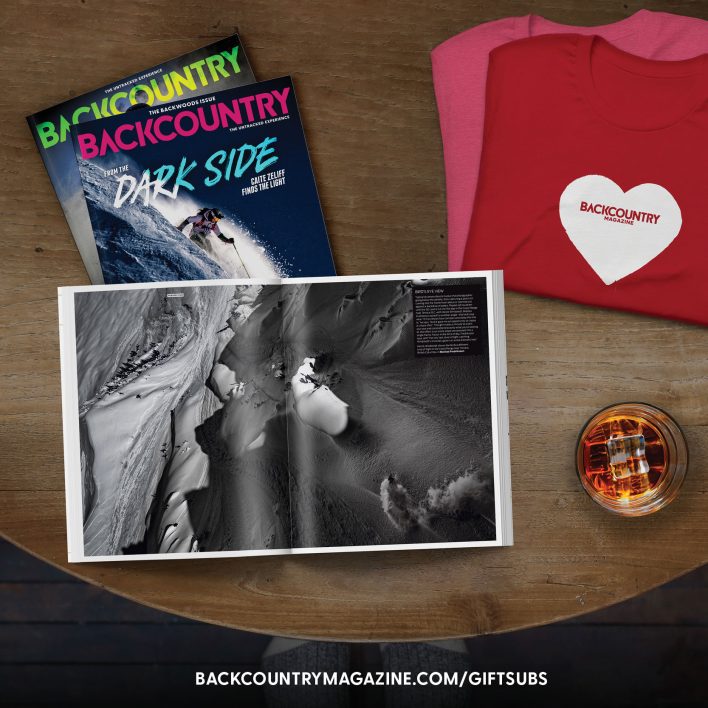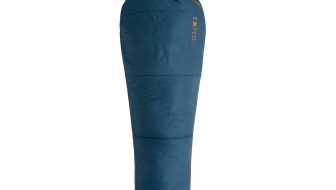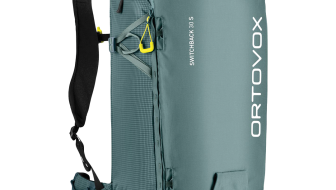While the number of resorts offering a guided backcountry experience continues to grow, one program remains unique: At Utah’s Solitude Resort patrollers literally cross the line, doubling as guides in their Backtracks program. It started in 2003 and in early February of that year editor Adam Howard joined line patroller and lead guide Ian Reddell to report on this one-of-a-kind take on out-of-bounds skiing (Backcountry, November 2003).
Nearly 10 years to the day later Howard found himself at Solitude again. With recorder in hand he went looking for Reddell to see what had changed and what hadn’t beyond the ropes in Big Cottonwood Canyon. He found Reddell atop the Powderhorn lift, at what mountain ops folks call PHQ, recovering from a few long and early mornings of control work after a series of gusty one-foot storms.
Reddell, now snow safety director at Solitude, is no longer a line patroller, or a Backtracks guide. So, joining the conversation was Caleb Merrill, a young patroller charged with taking clients into the backcountry through one of several gates at Solitude.
BCM: So, 10 years ago, like right now, we were here heading out a gate on a little tour over into Silver Fork Canyon.Reddell: Yeah, that was the first year we had the program.
BCM: And it was unique at the time because here was this out-of-bounds backcountry program that was operated by the ski patrol. You know of any others that do that?
Reddell: I don’t. They usually contract out to guides.
BCM: What’s changed in the last 10 years?
Reddell: People seem to be a lot more aware of the distinction between the backcountry and the ski resort. They want to check it out, curious about it even more so than before, and with that, you know, the equipment’s changed significantly. The equipment we had 10 years ago has changed from what we provide today: Ten years ago we had Alpine Trekkers. Today we have a compete package that we provide for our clients. Most of them do not have this kind of equipment so it’s really nice to provide them with the specifics for getting around the backcountry a little bit easier. It really has changed how people get around.
BCM: So, let’s talk about the backcountry in general—the general users in the Canyons here. We’re seeing more accidents, avalanche fatalities and scenarios playing out. Is that a result of people just not knowing what’s going on, or is it just a volume thing?
Reddell: The percentages haven’t changed but the volume of users has increased significantly and that comes back to today’s modern gear, as well, I believe. Accidents are always going to happen in the backcountry. I think we’re really fortunate in the Wasatch with the people that use our gates. They all seem pretty savvy. You hardly ever see the solo person heading out. People are going out with partners or in small groups, for the most part, and they all have…they all appear to have all the appropriate equipment. I think there is a pretty high standard for the backcountry users as a whole here.
There is a lot of depth and a lot of experience and very well educated people that seem like they do educate the newer group coming through that you need to have certain skills in order to be out there. That’s certainly something we impress upon folks when they come through is a do you know where your going? Who are you traveling with? Do you have the right equipment? People have the option to make decisions on their own but we can certainly encourage them to a have the right equipment and be educated so if we see something that doesn’t look right we’ll talk to people. Also, the Utah Avalanche Center has an excellent web page here, and they are very public and very easy to get information you need. We also have beacon checkers now at the top of our summit lift, which we never had before.
BCM: So how long have you been here Caleb?
Merrill: This is my seventh year and I’ve been managing the Backtracks program for about four or five years.
BCM: How many tours have you run this year?
Merrill: We have run eight or 10 tours this year. That’s about average for this time of year. We average a tour a week
BCM: Maybe 20 a year or so?
Merrill: Yeah, we have 200 user days [permitted by the U.S. Forest Service]. So, a user day is one person, so if you have four clients that’s four user days for one tour. Some years we’ll hit a hundred user days, maybe bump over a hundred.
BCM: From a business perspective, it’s not a really moneymaker….
Reddell: If that’s all that we had and we were running those numbers, we wouldn’t be able to sustain it. But, I think it’s a really unique situation. Fortunately, upper management sees this as something that’s a really unique tour, something to offer their guests that are here in Solitude versus the normal ski day and they feel like it’s got value for the guests that are coming through and staying here and as well as for the patrol. [Laughs]. It’s certainly very enjoyable for the patrollers out on tour and it keeps us always thinking and staying really busy going out into the backcountry and digging pits out there and following the conditions as they are happening beyond our ski area boundaries.
BCM: Has it helped you become a better patroller?
Merrill: Yeah. I think in terms of forecasting: A lot of times were thinking about skier-compacted in-area stuff within the avalanche mitigation side of things. So it’s giving me more skills to be able to forecast for a little bit more of a natural snowpack in the backcountry.
BCM: Has the type of person signing up for the program changed in the past 10 years?Reddell: It used to be people that were just in town from either out of state or out of the country or staying in the village looking for a different activity. Especially quite a number of European folks more used to the whole guided scenario situation. As Caleb said, today it seems like we’re impacting more people that are local that want to check it out in a safer, more responsible manner by hiring a guide to take them out.
BCM: So the whole guide/client culture that, 10 years ago, was not the American way has changed?
Reddell: I think that there is other information out there that people are seriously considering before going into the backcountry. They’re recognizing that, “Yeah. This is something that we shouldn’t do lightly, so how do we get more educated?” Whether it’s through magazines or the Internet or on smart phones, more people are recognizing that there is a certain way to proceed, going in the backcountry.
BCM: So it seems the program’s changed a lot over a decade….
Reddell: It’s really gotten refined now. It’s become more efficient with time just like the equipment has improved. It’s just such a smooth operation, and we have terrain atlases now with photographs. Before it was a lot of local knowledge: talk about what runs we’re gonna take people on but now we’ve gotten some nice photographs of the backcountry with our terrain atlas that our patrol can a check out….
Merrill: Another big thing we try to do day to day with patrol is backcountry terrain familiarization with some of the newer guys and get them out there on some slower days and show them where we operate.
Reddell: That means take ’em in the backcountry and go skiing. They love it. We just really put it together so it’s a positive program. Clients enjoy it. Guides enjoy it. Patrollers getting into it are enjoying it, learning the terrain. It’s been a real positive morale program that we have for the guys. On that day off they go do something different, still get paid, and can’t believe they’re getting paid making some fresh powder turns all day.
For more information about Solitude’s Backtracks visit: solitudebacktracks.com
Editor’s Note: Check out the original story on the Solitude Backtracks program from the November 2003 issue of Backcountry, republished here.















Does this program still exist? We’re heading to Solitude in a few weeks and would love to explore the back country.